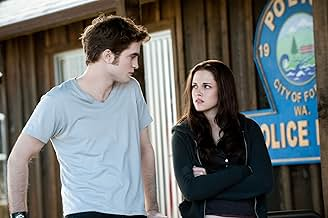Eclipse: A Vampire Love Triangle Revisited
In the third installment of the “Twilight” saga, vampire Edward and werewolf Jacob once again vie for the affections of mortal Bella, while the director attempts to compensate for their drawn-out squabbles with energetic vampire fight scenes.


Bella and her vampire lover Edward are reunited, with Edward persistently proposing marriage. Bella, in turn, insists on being “turned.” Jacob, once again left out in the cold, sulks in his reservation. Meanwhile, Victoria roams the forest, seeking revenge on Edward for the death of her beloved, and strange murders occur in nearby Seattle, believed by the Cullens to be the work of “newborn” vampires.
A “Twilight” screening is a noisy affair. Every word spoken on screen is met with enthusiastic reactions. The concept of “imprinting” is particularly exciting. The cheerful buzz subsides only during fight scenes, only to return with renewed vigor during scenes of romantic declarations. After the screening, young women gaze mysteriously into the distance, while their male companions look at them with bewilderment. “Did you really like it?”
The “Twilight” saga has quickly outgrown the confines of mere books and movies, now viewed as a phenomenon of either culturological or socio-pathological significance. There’s little else to analyze. Like his predecessors, director David Slade has done his job, earning enough for his next indie project and a comfortable life, regardless of the opinions of “Saga” fans and detractors.

Despite another change in leadership, “Eclipse” maintains the same tone, spirit, and color palette as the previous films. Slade clearly enjoys the dramatic confrontations, such as the Volturi in moth-eaten camisoles or the Cullens in their pacifist uniforms, emerging from the fog. However, during the prolonged relationship dramas – close-ups of faces, one shimmering, the other fading – he seems to lose his sense of rhythm, simply fulfilling the requirements. The target audience, as the producers likely explained while writing the check, comes to see Bella clinging to Jacob’s bare torso, not to watch him as a poorly rendered ball of fur darting through the forest. And who knows, maybe it’s not even him; it’s hard to tell those werewolves apart.


Kristen Stewart, who cut her hair for her role in “Runaways,” wore a wig during the filming of “Eclipse.”
David Slade once claimed he would never touch the “Twilight” franchise, but when his appointment as director was announced, he retracted his words, claiming he was just joking to promote his comedic short films.

The Appeal to the Target Audience
It’s clear why the target audience enjoys the saga so much. Firstly, even Edward gets nervous and inquires about a shirt when he sees Jacob’s muscles. Secondly, aside from the inter-clan fantasy battles, the story presents a dream. Two young men from good families revolve around a longing maiden, essentially dealing with the question of who gets to watch over her bed tonight. Not in a bad way, of course – just to make sure she doesn’t get hurt in her sleep. Occasionally, their circling leads to nose-to-nose encounters, after which they flash their pearly whites and resume their movements. Both young men are incredibly handsome, making the choice between them purely a matter of taste. One is pedigreed, well-mannered, and persistently proposes marriage. The other, in contrast, is wild, passionate, and offers “flesh and heart with blood.” And while the latter promises love until death, the former swears allegiance even after death.
Bella herself serves as a mere baton in this story, and in the most dramatic moments, as bait. This isn’t necessarily a flaw of the franchise, but rather a functional advantage. If the main character is a void, it only makes it easier for each young woman to insert her own head into that void… And how can one not shout at the crucial moment: “Say yes, you fool, say yes!” And how can one explain to a suitor who has neither loyalty to marital bonds nor a gym membership, where that dreamy look comes from.